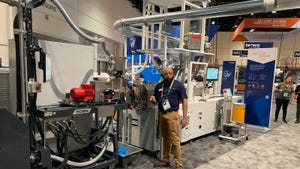Investment in backmolding technology pays in customer trust
July 25, 2002
|
More than 80 people work in Georg Kaufmann Formenbau's well-equipped moldmaking shop, 15 of them in the design area. A free-standing technical center for R&D and mold trialing also opened recently. |
Editor's note: In the Focus: Niche Processes section of July 2002 IMM (pp. 10A-11A), we showed Krauss-Maffei's Injection Molding Compounding system, including an auto tailgate molded and inmold laminated at K 2001 in Germany. No less interesting than the machine is the mold that was made by Georg Kaufmann Formenbau AG. This moldmaker has built a solid reputation as a specialist in tools for backmolding and inmold lamination. The company recently took steps to be even more competitive in backmolding tools.
Georg Kaufmann Formenbau AG (GKF) of Busslingen, Switzerland began making molds for back-injection (BI) molding more than 20 years ago. Well-deserving of the title "pioneer" when it comes to inmold laminating, GKF to date has delivered more than 1000 BI molds, plus more than 600 tools for back-compression-injection (BCI) molding. With barely a look backward, the company recently celebrated its 30th anniversary by making major new commitments and investments to support its inmold lamination specialty.
Back-compression machines |
During the anniversary celebration in May, GKF opened a new freestanding technical center that lets it give its primarily automotive customers a higher level of support and service. The focus of the center is a new 420-metric-ton Krauss-Maffei machine. It is specially modified for BI and BCI (see sidebar), as well as for another back-injection process recently developed by GKF to cut cycle time and ensure maximum appearance quality, even with more delicate films and foils.
Design, Process Development
Over the last five years, GKF has expanded its international presence by supplying tools in cooperation with partners such as RS Meccanica in Italy and Delta Tooling in Auburn Hills, MI. In addition, a subsidiary operation in Gastonia, NC called GK Tools USA is helping auto industry designers gain the development, cost, performance, and environmental benefits of inmold laminating. Company revenues for 2001 were 24 million Swiss Francs ($16 million).
When Georg Kaufmann started the company 30 years ago, he was a designer by training and experience. He was one of the first to realize the potential of the low-pressure molding technology developed by Siebold Hettinga and quickly worked on the molds used in the process. An emphasis on design has proven to be a good policy as OEMs and Tier One suppliers have increasingly turned to suppliers for upstream development of their concepts. Of the 80 employees at GKF's facility, 15 of them are in design.
The company has stayed on the leading edge of CAD/CAM technology, and part of the recent investment package went toward the latest in 3-D CAD modeling software. There are now 10 stations of AutoCAD and two of Catia. In addition, there are five Euklid CAM stations and three of Work NC. A robust internal network means all CAD data pass directly from the design station to the tooling equipment. There is no need for a model between CAD and steel.
|
With inmold laminating of surface film, back-injection and back-compression molding are adding exterior body parts and more to its base in interior panels such as these. |
Process development is as critical as design and was a driving force behind the recent investment in the technical center, special injection molding machine, and CAD systems. At K 1998, GKF showed an early phase of a new form of back-compression called melt-flow back-injection molding. The new technical center will accelerate its use by allowing customers to see the benefits firsthand.
In both BI and BCI processing, the laminating foil or film is placed in the mold first. A BI mold is closed and then injected. A BCI mold is left slightly open, injection takes place, and the mold closing is used to distribute the material evenly. BI works best with small to medium parts; BCI works best with larger parts such as complete auto door panels.
In molten-layer BCI, a movable wide nozzle applies a layer of melt onto the core of an open compression tool. In melt-flow BCI, the tool is first closed on the laminate, and then it reopens slightly, and the melt is injected onto the core through a special high-volume hot runner system. In both types of BCI, the substrate is formed and bonded with the laminate by a very precise mold closing that fills all the corners and attachment points on the substrate.
Improving What Works Well
Back-compression was a significant improvement over simple back-injection in that larger, more complex parts could be made and the surface quality of the laminate was notably improved. Melt-flow BCI's advantages include shorter cycle times for higher productivity. The reduction varies with the size and complexity of the part, but reducing a 70-second cycle to 60 seconds is typical.
Additionally, the handling of the surface laminate is done vertically, which is both easier and more consistent than horizontal insertion. Kaufmann says the equipment investment is lower, and the machine takes less floor space than an older system. The process ensures virtually no bubbles or wrinkles in the surface laminate. Perhaps the biggest benefit of all, says Kaufmann, is that the shot-to-shot repeatability is greatly improved.
GKF generally reinvests 8 to 10 percent of its annual turnover to improve its services, and in some years that can reach 12 percent. Kaufmann says that the investments the company has made over time and now in the technical center, production machinery, and CAD systems are not optional. Rather, they are necessary to provide what the market needs. He also notes that these investments can return dividends. The company's most important working capital today, he says, is the trust its customers have in its competence.
Contact information |
You May Also Like



